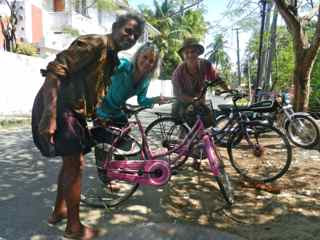Happy Valentine’s day. After an overnight bus trip from
Pondicherry to Bangalore (sleeper bus, quite comfortable, except for the really
bad patches of road), we stickhandled our way through the local buses to get to
Oso Dodi Gate, where the Gurukula is located.
A Gurukula is a place partially supported
by followers of a guru based in Varkala, Kerala. They have other spaces as well, and this one is on twenty
acres of land outside Bangalore.
Ma (Margaret) is the one who lives here and manages everything. Visitors come during the year, and
especially on this weekend for the annual Guru Puja, where the guru comes and
people come from all over to celebrate and hear his words. There has been a legacy of spiritual
masters who have influenced this place, starting with Narayan Guru, and the the
Nataraj Guru. The current master, Muni
Narayan Prasad, arrives tomorrow morning, and Amy and I will volunteer to help
set up the place for an influx of perhaps hundreds of people on Sunday. There will be music on Saturday night,
and I have already played guitar with Abe and Sajeev, Abe playing wonderful bamboo
flute and singing simple ragas that I am able to accompany.
This place is beautiful, natural, very
simple. It is a place of
contemplation, reading, yoga, and helping with the cows and gardens, preparing
food for people, setting up canopies for the yoga space and some tents for
people to stay. There are many
other animals here too, four dogs, three cats, many varieties of birds and
butterflies. Tonight we watched
the quarter moon setting to the west, and it was quiet and peaceful. I am really enjoying my time here
already, and looking forward to Guru Puja and beyond.
Ma is an amazing woman, yet another “little
guru”. She is older, but looks
very young, beams with love and light, and works through everything that needs
to be done in this busy place.
Things are hard to get done, with workers making promises and then not
showing up. In the past two weeks,
with financial help from donations, she was able to install a new pump for the
drinking water well, so we now have fresh clean well water that is safe to
drink. The cow provides milk,
paneer, yogourt, and food for the two new calves born a couple of months ago.
We also met Ma’s daughter and son-in-law,
Manjeri (Manju) and Henry. They
are a wonderful couple who have many “children”, including several species of
animals, dogs, cats, and even a pet monkey. However a traumatic think happened today to Mommy
Manju. Her pet monkey, Rhea,
suddenly got sick and died after Manju and Henry left them with people to come
here. Rhea was rescued at a few
days old, when here mother was killed.
She ended up coming home with Manju and Henry, and as they said, she is
more human than most humans. Her
sudden death was the loss of a child for them. The are taking the bus back to Hyderebad to deal with the
situation, and to make sure there is no virus that can spread to other animals
in the household. They will return
by bus tomorrow night, arriving Saturday morning. What an intense day for them (and us). Our love goes out to them.
More to come on Gurukula experience. (Sorry no pictures – our camera was
stolen!)






























